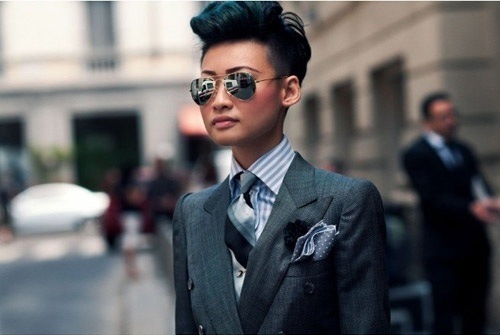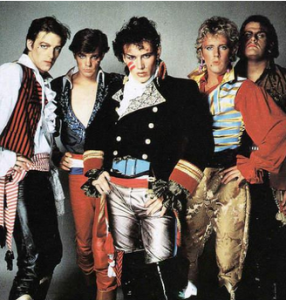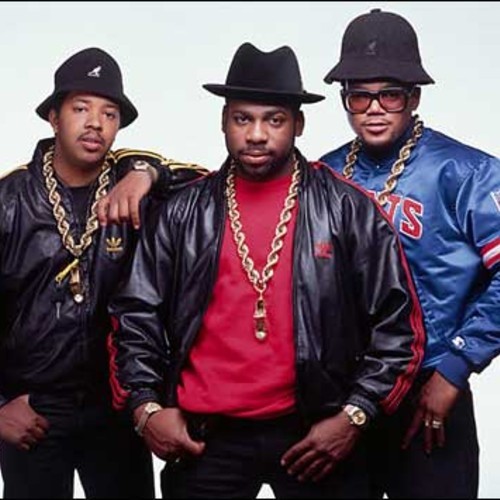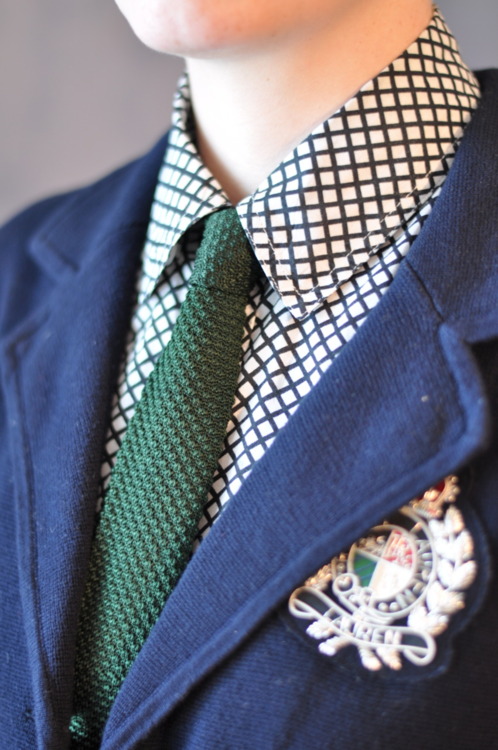Author | Christiane Nickel | Fashion Editor
This post is also featured on the blog Qwear
Please note that the featured image is an advertisement for Ralph Lauren’s Purple Label which explores the nuances of the English Dandy look
Prep and trad style have a rich and complex history in America which dates back to the 18th century fashion’s perversion of Anglomania. Universally associated with white privilege, notions of New England, and Ivy League culture, prep is a lifestyle and a philosophical mode of dress.

I grew up in Fairfield CT wearing self-sewn skirts (one was a collage of small mirrored tiles super glued onto a blue eyelet pencil) and Hot Topic band tees. Prep for me was an unfortunate part of life that added more fuel to my angsty gothic fire. Although I no longer identify as goth I found this to be integral my coming out process and queer identity.
My first encounter with queer prep was in Boston, with its infinite array of the sporty bro’ ‘mos. This subset of Boston queers was infamous for donning double popped collars, “Live Strong” bracelets, and madras shorts. This queer take on collegiate style could be found all over lesbian hot spots from Tribe, Toast, or in P-Town at a Tea Dance during Memorial Day Weekend. Although this style tribe seemed unintentionally subversive, the wearers adopted the visual markers of prep and gave it a queer context. As Qwear editor-in-chief Sonny Oram noted, “when a person is doing something that they know will cause them to lose privilege (dressing in a gender-nonconforming way) they might look for ways to leverage themselves in other areas (dressing like a well-off, educated white person).” The subversive and political elements among queers in preppy clothing was revolutionary and inspiring for me.


With the advent of McCarthyism, American consumerism and the baby boomer generation Prep became a mainstream throughout the 40’s and 50’s, especially in the Ivy League style of dress. It wasn’t until the ’60s with the Vietnam War and countercultural movements such as the Mods and Hippies that Prep fell into the periphery and was negatively associated with the establishment/patriach. During my time in grad school I delved more into the roots of prep, and asserted that it’s sudden rise in the ‘80s was, a counter cultural movement in itself. In light of postmodernism, much of this decade was a synthesis of different street styles including the New Romantics, Punk and Goth and Hip Hop. Adorned in eye searing colors and a blaring mashup of historical costume, the New Romantics along with Hip Hop provided a more prismatic and upbeat alternative to raw-edged studded leather bounded punks or the brooding Goths replete in corsets, crushed velvet and make up that idealized a deathly pallor. In spite of their stylistic deviations, it’s no surprise than with the overwhelming amount of style tribes throughout the ‘80s, that Prep’s clean lined conservatism seemed like a respite.

Lisa Birnbach’s seminal satire, The Preppy Handbook, outlines the essentials of the prep life style with sections like “Prep I: The Basic Reading List,” “The Politics of Monogramming and finally, “Fashion Fundamental.” There are striking similarities among the author’s prep ideology and queer style.
Of the ten trad “Fashion Fundamentals,” Androgyny is listed as tenth on the list: “Men and women dress as much alike as possible and clothes for either sex should deny specifics of gender. The success of a Lanz nightgown is based on its ability to disguise secondary sexual characteristics, while the traditional fit for men’s khakis is one size too big.” While androgyny in prep seems to be fundamentally rooted in sexually repressed Victorian society, queer culture (many would argue) employs it as a vehicle for professing alternate genders and sexual orientations. Sonny told me, “When I started addressing my gender presentation and making the scary shift to my trans*/genderqueer identity, I had a major preppy phase. I not only delighted in all those clothes my friends had a love/hate relationship with because they were a sign of privilege, but I found that preppy brands in the women’s department suited my gender identity better than anything else there.”

On another account from an acquaintance of mine… “When I was growing up and finding my body was not fitting my previous clothing that I was accustomed to as a tomboy, I would wear sweaters embarrassed of my own chest. Then one summer I discovered that even in suburban Ohio or southern areas like Florida, Hollister, the Lacoste department at Nordstrom, Abercrombie, and even H&M were offering sizes that would compliment me while allowing me to feel comfortable in my own gender neutral skin.”

When queers reinterpret the prep style, it is no longer worn within its traditional context of privileged heteronormative society. There, it becomes organically progressive. The formulaic nature of prep dress can be challenged and reinterpreted, and the original clean lines and versatile styles can grow again with the community on their terms. Regardless of its socio cultural vestiges, the Prep style is a unique compendium of seasoned sophistication, androgyny and a deep appreciation for rich color and timeless patterning.
Brands like Saint Harridan, Scouts Honor, and Tomboy Tailors, to name a few, adapt the vestiges of prep style (madras plaid bow ties, candy colored ties mixed with navy gingham button downs, khakis) for queer bodies. Crisply tailored maid-to-measure suits are an imperative element of trad style, as outlined in The Prep Handbook. The mixing of dapper with prep is another major influence allowing for a quirkier English aesthetic with more pattern and variety. Alone the fact that trad is often being worn by gender non-conforming queer bodies transforms all notions of this calculative and conservative style to becoming a highly individualized look that celebrates the legacy of prep while renouncing its antiquated notions of race, class and gender.
